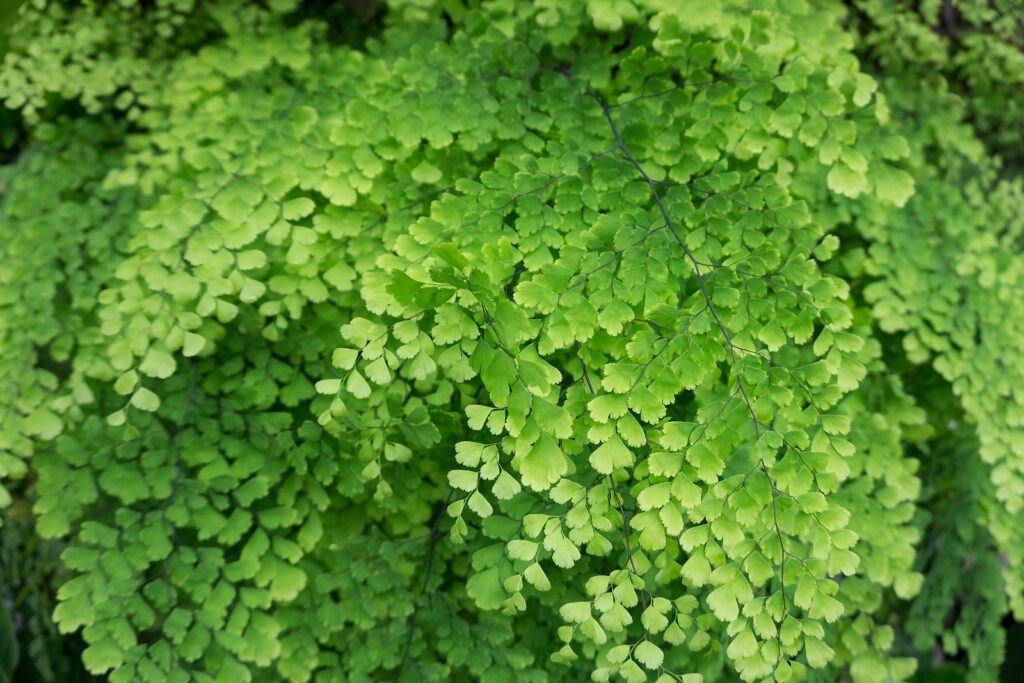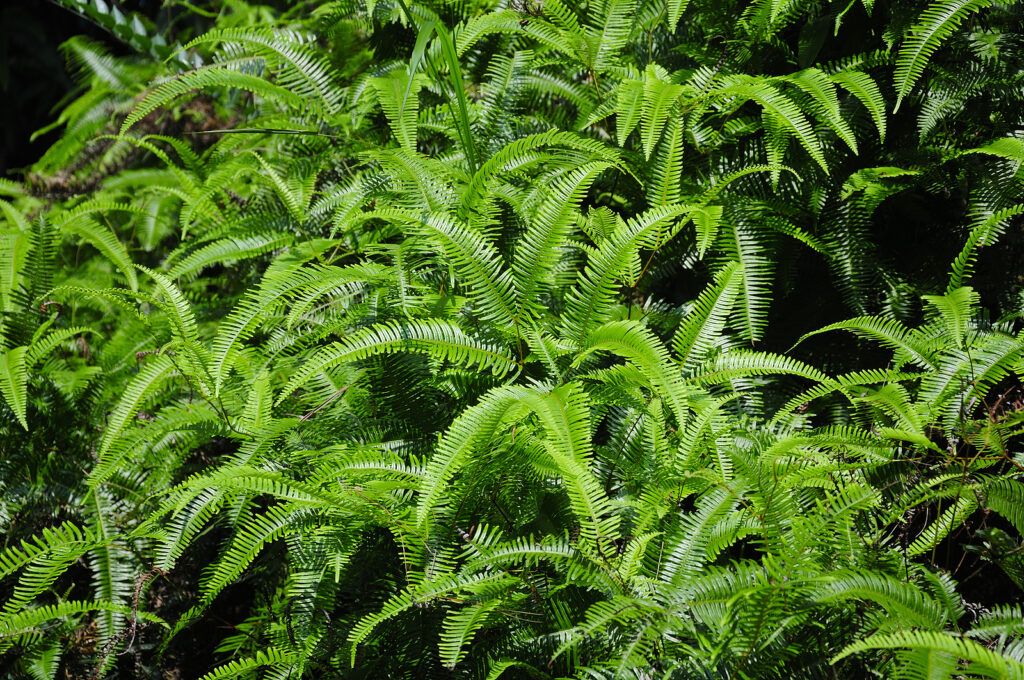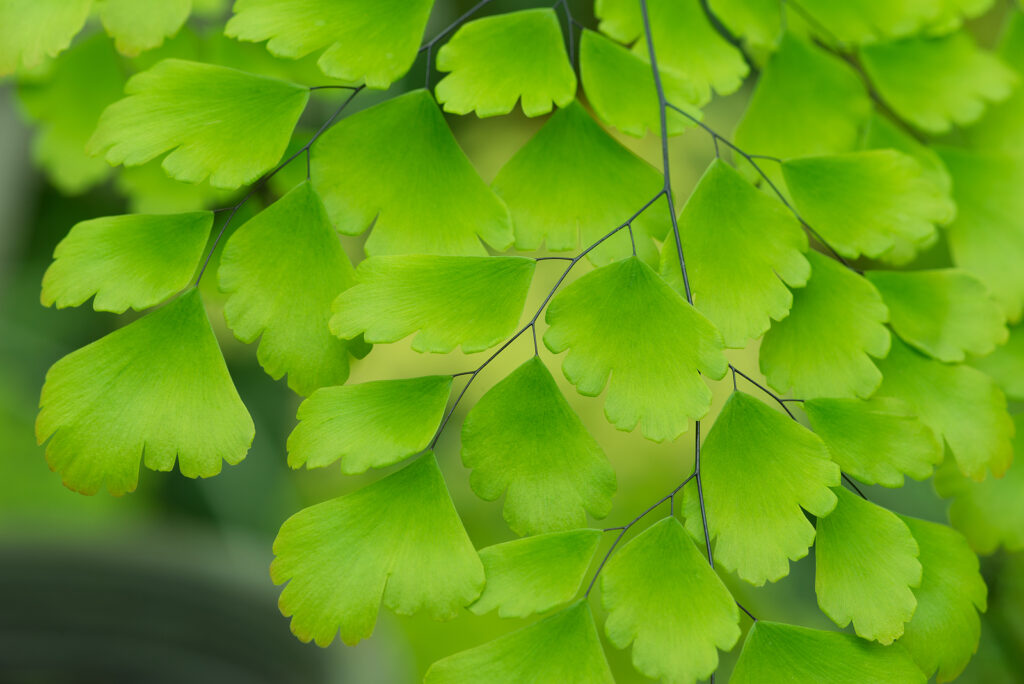Adiantum — maidenhair ferns–are moisture-loving perennials with fronds of leaflets that are mostly fan-shaped, bright green, and thin textured. Adiantum are grown for their delicate and elegant foliage.
Adiantum are tender plants that need shelter from the wind and hot sun and protection from winter cold. They are often grown as houseplants.
Adiantum is a genus of more than 200 species. Adiantum is native to tropical and subtropical areas of North and South America.

Get to know Adiantum
- Plant type: Moisture loving perennial
- Growing zones and range: Zones 3 to 8
- Height and width: 10 to 24 inches x 18 inches (25.4 to 61cm x 46.7cm)
- Form and habit: Creeping rhizomes
- Foliage: Branched, delicate, lacy, light green fronds that have an unusual “five-finger” pattern on shiny black stems that are divided into three or five featherlike (pinnate) leaflets; fiddleheads and new leaves are often pink in color
- Uses: Moist woodland gardens and as filler in bouquets
- Garden companions: Soloman’s seal or hosta
- Common name: Maidenhair fern
- Botanical name: Adiantum
- Family name: Peridaceae
- Origin: Native to tropics; some originate in North America
Where to plant Adiantum
- Plant Adiantum in shade to half sun; will tolerate some sun if soil moisture is plentiful and reliable, but unlike many ferns they do not grow well in deep shade.
- Plant Adiantum in well-drained, neutral to limy soil enriched with organic matter.
- Add agricultural lime to acid soils according to soil test results.
- Adiantum species listed as tender or indoor plants sometimes succeed in sheltered places in mild-winter areas.

When to plant Adiantum
- Set Adiantum in the garden in spring after all danger of frost has passed.
Planting and spacing Adiantum
- Grow Adiantum 18 inches (45cm) apart in filtered light.
How to water and feed Adiantum
- Keep Adiantum continuously moist, especially during dry summers.
- Feed Adiantum with an all-purpose organic fertilizer in spring.
How to care for Adiantum
- Leaves of even Adiantum hardy species die back in hard frosts.
Growing Adiantum as a houseplant
- Adiantum capillus-veneris, Venus’s hair, can be grown as a houseplant. It has light green fronds with fan-shaped leaflets.
- Give Adiantum subdued light from a northern exposure year-round. It grows well under artificial light.
- Adiantum will grow indoors at average room temperature with high humidity.
- Keep the soil evenly moist.
- Fertilize once in spring and once in summer.
Adiantum pests and diseases
- Scale insects can occur when growing Adiantum indoors.
- Adiantum is susceptible to aphids, fungus gnats, and mealybugs. Use a soap spray to control insect pests.
- Fungal root rots can occur but are rare.
Adiantum propagation
- Propagate Adiantum by dividing the plant’s crown in early spring.
- Sow spores as soon as ripe at room temperature.

Adiantum varieties to grow
- Adiantum aleuticum, Western maidenhair, native to Western North America and eastern Asia, is a similar species. Hardy in Zones 2 to 8.
- A. capillus-veneris, Southern maidenhair fern, to 1.5 feet (.5m) tall, fronds twice divided but not forked, glistens in shade. Zones 7 to 10.
- A. hispidulum, Rosy maidenhair, native to tropics of Asia, Africa. Indoor or greenhouse plant. To 1 foot (.3m) tall. Young fronds rosy brown, turning medium green, shaped somewhat like five-finger fern (A. aleuticum).
- A. jordanii, California maidenhair, native to California, Southern Oregon. Twice-divided fronds to 2 feet (.6m) tall.
- A. pedatum, Northern maidenhair fern, a 1-1.5 foot (.3-.5m) tall native North American fern with lacy, flat fronds that are branched in a horseshoelike manner.
- A. peruvianum, Silver dollar maidenhair, native to Peru. Indoor or greenhouse plant. To 1.5 feet (.5m) or more in height. Segmentsof fronds quite large, to 2 inches (5.1cm) wide.
- A. raddianum (A. cuneatum, A decorum), native to Brazil. Tender fern for indoors or greenhouse. Fronds cut three or four times, 15-18 inches (38.1cm-46.7cm) long. Many named varieties differing in texture and compactness. Grow in pots; move outdoors to a sheltered, shaded patio in summer. Varieties commonly sold as ‘Fritz-Luthii’, ‘Gracillimum’ (most finely cut), and ‘Pacific Maid’.
- A. tenerum, native to New World tropics. Indoors or greenhouse. Long, broad fronds arch gracefully, are finely divided into many deeply cut segments .5-.8 inch (1.3-2cm) side. ‘Wrightii’ is similar or identical.
- A. vanustum, Evergreen maidenhair, grows 12 inches (30.5cm) tall with pale green fronds on purplish black stems. Fronds have a blue tint in summer and turn yellow-brown in autumn.
- ‘Japonicum’ fronds emerge pinkish bronze.
- ‘Miss Sharples’ has chartreuse new growth and larget leaflets.















